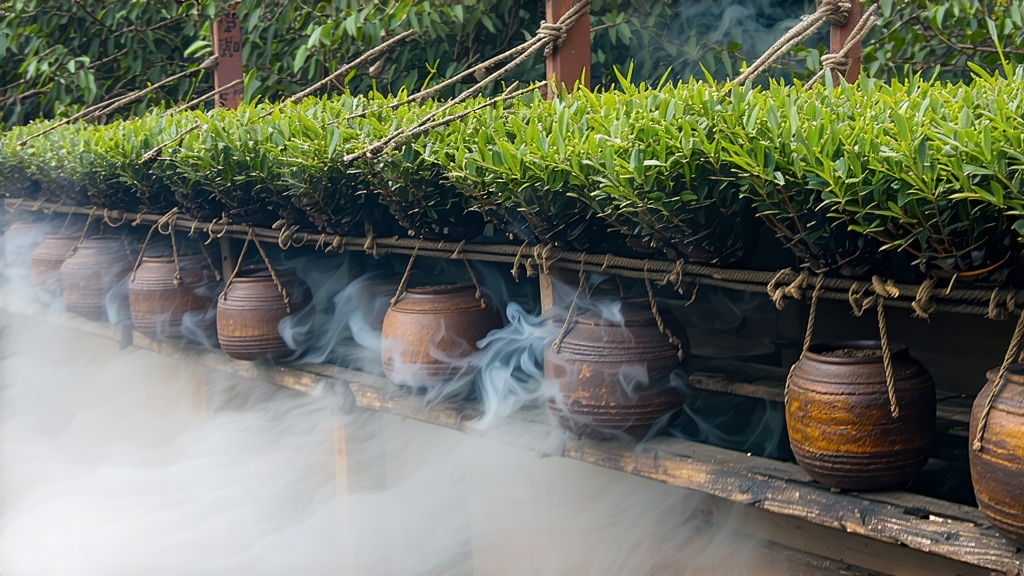
Long before English merchants coined the term “black tea,” Chinese hill folk in the Wuyi range of northern Fujian were already charcoal-drying leaves over smoldering pine boughs. The tea they produced—today spelled Lapsang Souchong—became the first fully oxidized leaf ever exported from China, carried in 1604 by Dutch clipper to Amsterdam and later by East Indiamen to London, where it shocked European palates accustomed only to green cakes. In the archives of the British Museum a 1662 entry lists “Bohea Souchon” among the wedding gifts of Catherine of Braganza, the Portuguese princess who popularized tea at the English court. Thus, the world’s earliest image of “Chinese black tea” was not the malty liquor of Assam or the winey fragrance of Keemun, but the unmistakable campfire aroma of Lapsang Souchong.
Geographically, the tea is inseparable from Tongmu Guan, a protected enclave inside the Wuyi National Nature Reserve where humid subtropical air collides with mineral-rich, weathered igneous soil. The micro-valley traps morning mist that slows photosynthesis, concentrating amino acids and volatiles in the spring buds. Only six natural villages—Ban Shan, Guan Ping, Miao Di, Jiang Dun, Miao Xi, and Lei Wen—are legally entitled to label their leaf “Zheng Shan Xiao Zhong,” literally “Original Mountain Small Sort,” a designation codified by Chinese national standard GB/T 13738.3-2012. Anything produced outside this 50 km² core must content itself with the generic “Waishan” (outer-mountain) grade, a difference immediately obvious in the thinner, sharper smoke that clings to the cup.
The cultivars used are hyper-local descendants of the Wuyi shrub species Camellia sinensis var. sinensis forma bohea. Growers prize three clonal lines above all: Xiao Ye Zhong (small-leaf), Ye Sheng (wild), and the newer Wuyi Qizhong 105, selected for cold tolerance and higher catechin-to-theaflavin conversion. Spring plucking begins when the valley’s wild azaleas bloom, traditionally on Qingming festival but now adjusted 5–10 days earlier because of climate drift. Two leaves and a bud are snipped at 45°, never after noon, to keep cell turgor high for the bruising stage that follows.
Crafting Lapsang is a dialogue between wood, air, and timing. Withering happens in a two-story Qing-style wooden lodge called a qing lou. Pine logs—preferably resin-heavy Masson or Chinese red pine aged three years—are lit in a pit below slatted bamboo trays. The fresh leaf is laid one finger-width thick; warm smoke, kept below 45 °C, wafts upward for 6–8 hours, deactivating leaf enzymes while impregnating the surface with guaiacol and syringol, the same phenols that give smoked bacon its aroma. Once the leaves turn jade to olive, they are rolled for 45 minutes on a cast-iron kneading table, breaking cell walls to release polyphenol oxidase. Oxidation follows in cedar-lined boxes; the leaf pile is covered with wet hemp cloth to maintain 26 °C and 85 % humidity. Here the magic of theaflavin formation occurs, shifting leaf color from copper to dark chocolate in roughly three hours—half the time of Yunnan Dian Hong because Wuyi leaf is thinner. Firing halts oxidation: baskets are placed over a hotter pine fire (90 °C) for two quick minutes, then transferred to a charcoal oven at 70 °C for a final eight-hour bake. The result is a strip-shaped leaf, 8–10 mm wide, glossy black with golden tips if the grade includes buds.
Western commerce soon demanded a less assertive version, so in 1850 a Tongmu elder named Jiang Shaochun experimented with liquid smoking: pine needles are boiled, the resinous steam piped into a sealed room where finished maocha is gently re-humidified and re-dried. This “unsmoked” Lapsang, sold as Zheng Shan Xiao Zhong “original flavor,” steeps into a brilliant amber liquor tasting of longan, lychee honey, and cooled campfire rather than kipper. Connoisseurs now speak of three stylistic